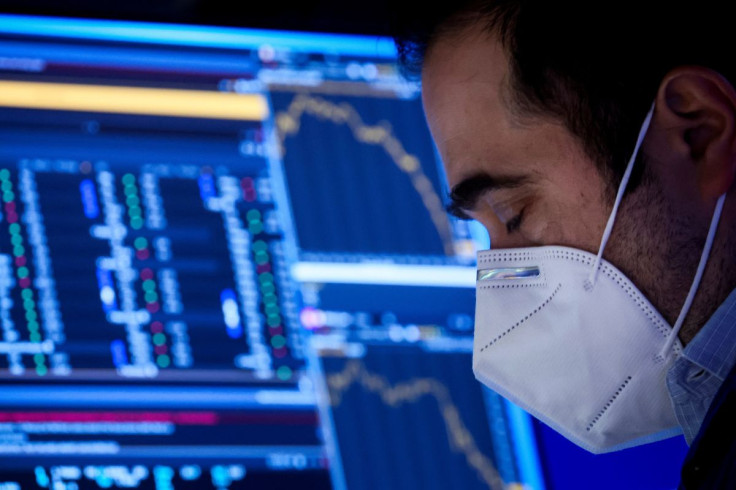Analysis - U.S. Yield Curve Flashing More Warning Signs Of Recession Risks Ahead

The U.S. government bond market is sending a fresh batch of signals that investors are increasingly convinced the Federal Reserve's aggressive actions to tame inflation will result in recession.
The shape of the yield curve, which plots the return on all Treasury securities, is seen as an indicator of the future state of health of the economy, as inversions of the curve have been a reliable sign of looming recession.
While Fed Chair Jerome Powell on Wednesday said that he does not see the economy currently in a recession, spreads between different pairings of Treasury securities - and derivatives tied to them - have in past weeks moved into or toward an "inversion" when the shorter dated of the pair yields more than the longer one. These join another widely followed yield spread relationship - between 2- and 10-year notes - that has been in inversion for most of this month.
"Curves are flattening and some are negative. They're ultimately all telling you the same thing," said Eric Theoret, global macro strategist at Manulife Investment Management.
A steepening curve typically reflects expectations of stronger economic activity, higher inflation and interest rates. A flattening curve can signal expectations of rate hikes in the near term and a weaker economic outlook.
The Fed is aiming to achieve a so-called "soft landing" that does not entail an outright contraction in U.S. economic output and the rise in joblessness that typically accompanies that. But the moves in the bond market over the past week show waning confidence in the Fed's ability to achieve so benign an outcome.
Some of those moves reversed slightly on Wednesday, with rates at the short end of the curve turning lower on expectations of the Fed being less likely to continue with super-sized hikes.
On Wednesday the Fed raised its benchmark overnight interest rate by 0.75% to a range of between 2.25% and 2.50% as it flagged weakening economic data. Powell said on Wednesday that achieving a soft landing for the economy was challenging.
The curve is indicating that the Fed will have to start cutting rates after hiking.
The part of the U.S. Treasury yield curve that compares yields on two-year Treasuries with yields on 10-year government bonds has been inverted for most of the past month and is around the most negative its been since 2000 on a closing price basis.
Powell, however, has in recent months said that the short-end of the yield curve was a more reliable warning of an upcoming recession.
"The first 18 months of the yield curve has 100% of the explanatory power of the yield curve, and it makes sense ... because if it's inverted that means the Fed is going to cut which means the economy is weak", he said in March.
Some analysts pointed to another measure, the differential between what money markets expect the three-month federal funds rate to be in 18 months and the current three-month federal funds rate. That went briefly into negative territory on Tuesday, said George Goncalves, head of U.S. Macro Strategy at MUFG.
That spread - measured through overnight indexed swap (OIS) rates, which reflect traders' expectations on the federal funds rate - was about 230 basis points in March.
"It's very similar to looking at the Treasury curve, these are all curves that trade with tiny spreads with each other," said Subadra Rajappa head of U.S. rates strategy at Societe Generale.
Another measurement of the curve, the 2-year forward rate for 3-month bills, is around the flattest since June 2021.
Fed economists have said https://www.federalreserve.gov/econres/notes/feds-notes/monetary-policy-inflation-outlook-and-recession-probabilities-20220712.htm that near-term forward yield spreads - namely the differential between the three-month Treasury yield and what the market expects that yield to be in 18 months - are more reliable predictors of a recession than the differential between long-maturity Treasury yields and their short-maturity counterparts.
That spread has not gone negative, though it has narrowed significantly from over 250 basis points in March to about 70 basis points this week, said MUFG's Goncalves.
Another part of the curve that compares the yield on three-month Treasury bills and 10-year notes has flattened dramatically over the past few weeks, from nearly 220 basis points in May to around 15 basis points this week although it steepened after Powell's remarks.
Separately, futures contracts tied to the Fed's policy rate showed this week that benchmark U.S. interest rates will peak in January 2023, earlier than the February reading they gave last week.
"Inverting yield curves, rising inflation, weakening housing data, and slumping surveys have all driven the increase (in recession probability) in the US," wrote Credit Suisse analysts in a research note on Tuesday, forecasting that the probability of the United States being in recession 6 and 12 months ahead is approximately 25%.
"It is likely recession probabilities rise further in the coming months if policy rate hikes cause further curve inversion and cyclical data continue to deteriorate," they added.
© Copyright Thomson Reuters 2024. All rights reserved.



















